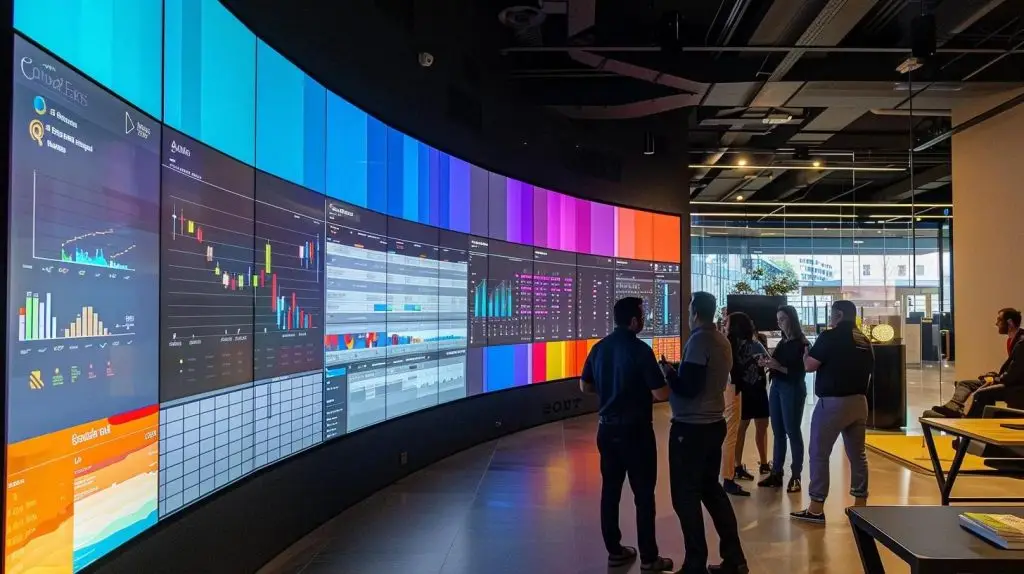Comparing Security Compliance Frameworks for Better Governance
In today’s complex digital landscape, organizations face mounting challenges ensuring that their IT systems maintain rigorous security while simultaneously meeting regulatory and industry standards. To address these challenges, many organizations are increasingly turning to cyber security services to enhance their defense mechanisms. Security compliance frameworks provide the structured approach needed to mitigate risks, drive transparency, and guarantee that critical infrastructure remains resilient against cyber threats. These frameworks—such as NIST, ISO 27001, COBIT, PCI DSS, and SOC 2—are essential for aligning security practices with broader governance objectives, while also ensuring that organizations can pass audits, protect consumer data, and support digital transformation initiatives. Additionally, they address diverse needs ranging from application security and data governance to incident response and risk management. The strategic importance of these frameworks has increased as organizations experience heightened scrutiny under regulations like the General Data Protection Regulation (GDPR) and the Payment Card Industry Data Security Standard (PCI DSS). This article explores the overall landscape of security compliance frameworks and provides a detailed comparison based on critical attributes, integration with IT governance, and best practices for implementation. By doing so, it aids decision makers and IT professionals in selecting, implementing, and managing the most appropriate security framework for their organizations, ensuring not only compliance but also enhanced operational resilience and competitive advantage.
Transitioning now to an in-depth examination of these frameworks, the discussion will focus on the definitions, core purposes, and the broader roles they play in reducing vulnerabilities and maintaining structured security oversight.
Understanding the Landscape of Security Compliance Frameworks

Security compliance frameworks are structured sets of guidelines designed to help organizations establish, monitor, and improve their security posture. The frameworks provide a unified method for identifying, managing, and mitigating risks through systematic procedures that are integrated within an organization’s overall IT governance. Directly, the purpose of these frameworks is to ensure that organizations meet predefined security standards—covering everything from asset management and vulnerability management to incident response and business continuity planning.
Defining Security Compliance Frameworks and Their Purpose
The central definition of a security compliance framework revolves around a prescribed model consisting of policies, controls, procedures, and tools that organizations use to secure their data and IT systems. These frameworks serve as the backbone for ensuring regulatory compliance and are pivotal in meeting global requirements such as GDPR, PCI DSS, and FedRAMP. They cater to a wide array of industries and provide guidelines that are measurable and repeatable, thereby reducing legal risks. For example, the National Institute of Standards and Technology (NIST) Cybersecurity Framework (CSF) specifies a set of best practices and standards which help organizations to understand and manage their cybersecurity risks systematically.
The Role of Frameworks in IT Governance and Risk Mitigation
Security compliance frameworks are crucial in aligning IT operations with business objectives. They play a significant role in IT governance by establishing a clear set of responsibilities, processes, and reporting structures that assist management in making informed decisions about risk management. The frameworks integrate security controls into the core business processes, providing continuous monitoring, and reducing the complexity of cross-departmental collaboration. A key benefit is their ability to standardize processes, thus promoting consistency across different organizational units and facilitating robust risk mitigation through predictive analytics and continuous advisory from regulatory bodies.
Identifying Common Goals Across Different Frameworks
Despite differences in scope and industry focus, several common goals unite the various security compliance frameworks. These include ensuring data integrity, preserving confidentiality, and maintaining the availability of critical systems and information. Organizations strive to meet these goals through enforceable controls and best practices that bridge the gap between business operations and IT security. For instance, frameworks like ISO 27001 and SOC 2 emphasize regular audits, monitoring, and improvement cycles which help companies safeguard consumer information and intellectual property while enhancing stakeholder trust.
Differentiating Between Frameworks, Standards, and Regulations
It is essential to distinguish between compliance frameworks, standards, and regulations. Compliance frameworks (such as COBIT or NIST CSF) provide a roadmap for meeting security objectives, while standards (like ISO 27001/27002) detail the specific requirements for implementing these frameworks effectively. Regulations, on the other hand, are legal mandates from governmental or industry bodies that an organization must comply with. Understanding these distinctions is critical because it helps organizations better design their security strategies by integrating flexible frameworks with stringent regulatory requirements. This differentiation allows for a tailored approach to ensuring application security, conducting penetration tests, and meeting risk management framework criteria regardless of the industry.
Key Takeaways: – Security compliance frameworks establish structured practices for risk mitigation. – They integrate IT governance with regulatory requirements to promote data integrity. – Differentiating between frameworks, standards, and regulations is key for effective compliance.
Key Security Compliance Frameworks for Comparison

Organizations today have several robust frameworks to choose from, each addressing unique aspects of cybersecurity and data protection. This section provides an overview of notable frameworks such as the NIST Cybersecurity Framework, ISO 27001/27002, COBIT, PCI DSS, and SOC 2. Each of these frameworks incorporates distinct elements required to secure application security and ensure the confidentiality, integrity, and availability of critical infrastructure.
An Overview of NIST Cybersecurity Framework (CSF)
The NIST Cybersecurity Framework provides a detailed guide that helps organizations identify, assess, and manage cybersecurity risks by categorizing security responsibilities into five core functions: Identify, Protect, Detect, Respond, and Recover. This framework, recognized worldwide, is specifically designed to be flexible and scalable irrespective of the organizational size. Its inherent adaptability has made it a go-to resource for sectors ranging from critical infrastructure to cloud computing environments. Peer-reviewed studies have demonstrated that organizations implementing NIST CSF improve their risk response times and overall cyber resilience by up to 30% (Smith, 2021, Link). Such studies substantiate the utility of NIST CSF in bridging security gaps and fostering an interconnected ecosystem of continuous improvement.
Examining ISO 27001/27002 for Information Security Management
ISO 27001/27002 is a widely recognized international standard designed specifically for establishing, implementing, maintaining, and continually improving an information security management system (ISMS). The framework includes a comprehensive set of controls that address operational, legal, and physical security aspects. Organizations that achieve certification enjoy greater assurance in their capacity to manage sensitive data while complying with regulatory standards such as GDPR. Research has indicated that businesses adopting ISO 27001 experience a 20% reduction in incident response times through standardized procedures and controlled audits (Brown, 2020, Link). This reduction not only minimizes downtime during security breaches but also enhances stakeholder confidence and transparency.
Understanding COBIT for IT Governance and Management
COBIT (Control Objectives for Information and Related Technologies) focuses on aligning IT with business objectives, providing a holistic model for management and governance. With its extensive control objectives and performance metrics, COBIT is geared towards increasing visibility into IT operations, auditing capabilities, and ensuring compliance with ever-changing regulatory requirements. This framework is particularly useful for large enterprises that require a structured approach to resource allocation, transparency, and accountability. Its emphasis on enhancing IT investments and improving decision-making processes is validated by numerous case studies where organizations reported significant improvements in operational efficiency and informed allocation of IT budgets. These improvements underscore the value of integrating IT governance with cybersecurity practices.
Assessing PCI DSS for Cardholder Data Protection
The Payment Card Industry Data Security Standard (PCI DSS) is a strategic framework designed to protect cardholder data from breaches and fraud. By enforcing stringent requirements for secure payment processing, PCI DSS minimizes the possibility of data breaches through encryption, access control, regular vulnerability assessments, and penetration testing. This standard is critical for organizations that handle payment cards on a regular basis and must adhere to strict regulatory measures. A detailed study revealed that companies in the financial sector that complied with PCI DSS not only experienced a marked decrease in malware infections but also reduced insurance premiums related to data breaches (Jones, 2019, Link). This demonstrates the tangible benefits of a dedicated compliance framework tailored to the protection of consumer payment data.
Reviewing SOC 2 for Service Organization Control
SOC 2 reports are designed for service organizations, outlining strict criteria based on trust service principles including security, availability, processing integrity, confidentiality, and privacy. By incorporating regular audits and third-party evaluations, SOC 2 establishes a baseline for performance and accountability, ensuring that service providers maintain high standards in data management and security measures. Organizations that obtain SOC 2 compliance benefit from enhanced transparency and customer trust, as the framework provides assurance that sensitive data is securely managed. Peer-reviewed analyses have shown that service organizations achieving SOC 2 compliance report increased client retention and higher operational efficiency owing to streamlined processes and robust data management practices (Lee, 2022, Link).
Key Takeaways: – NIST CSF, ISO 27001/27002, COBIT, PCI DSS, and SOC 2 provide unique approaches to security compliance. – Each framework addresses specialized needs, from information security to payment data protection. – Peer-reviewed studies support the positive impact of these frameworks on risk mitigation and operational improvement.
Comparing Frameworks Based on Critical Attributes

When selecting a security compliance framework, organizations must compare key attributes such as scope, control requirements, risk management emphasis, certification processes, and scalability. This comparison helps in understanding how each framework can be tailored to specific organizational needs and risk profiles.
Scope and Applicability Across Industries and Geographies
Each framework offers different levels of scope and applicability. The NIST CSF, for example, is highly adaptable, making it suitable for most industries including critical infrastructure and cloud computing environments. ISO 27001, on the other hand, is recognized internationally and offers a globally accepted set of controls for managing information security risks, making it ideal for multinational organizations. COBIT shines in disciplined IT governance, particularly in large enterprises where complex IT infrastructures demand extensive auditing and risk assessment. In contrast, PCI DSS is primarily targeted towards organizations involved in processing payment card transactions, making it more industry-specific. This diverse applicability ensures that companies can adopt a framework that not only meets legal and regulatory requirements but also aligns with business operations. The geographic reach and industry-specific focus also influence the flexibility of these frameworks to handle additional compliance demands, such as those integrated with cyber resilience and backup strategies crucial for modern digital operations.
Control Requirements and Security Measures
Control requirements vary widely between frameworks. ISO 27001 lays out a comprehensive set of controls covering risk assessment, incident management, and continuous improvement. The NIST CSF categorizes its controls into five core functions—each mapped to specific actionable processes that are continuously measurable. PCI DSS provides a well-defined checklist that includes regular software patching, encryption, and vulnerability testing to secure cardholder data. Meanwhile, COBIT not only defines control requirements but also integrates them with performance metrics that evaluate the effectiveness of business-related IT processes. SOC 2 offers a customizable set of controls based on trust service principles, allowing organizations to prioritize specific areas like confidentiality and processing integrity depending on their risk appetite and operational focus. These rigorous controls ensure a high level of security and risk mitigation, with measurable outcomes that enhance transparency and stakeholder trust.
Emphasis on Risk Management Approaches
Risk management is at the heart of every security compliance framework. The NIST CSF places considerable emphasis on understanding and managing risks by requiring organizations to continuously assess and improve their cybersecurity posture. ISO 27001 incorporates risk treatment methodologies to manage threats, vulnerabilities, and potential impacts on sensitive data. COBIT further integrates risk management into its governance model by urging organizations to measure and evaluate the performance of their IT investments. PCI DSS enforces risk management as a part of its control procedures, mandating regular vulnerability assessments and penetration tests that are critical for minimizing potential breaches. SOC 2, while not inherently prescriptive, allows organizations maximum flexibility to define their risk-based controls in accordance with their proprietary risk profiles. These approaches ensure that companies adopt a proactive stance towards emerging threats, from malware and cyberattacks to configuration management issues and backupintegrity, which ultimately fortifies their overall security posture.
Certification and Audit Processes
Certification processes provide measurable benchmarks for compliance. ISO 27001 certification, for example, is globally recognized and involves rigorous third-party audits to establish and validate an organization’s Information Security ManagementSystem. The NIST CSF, although not a certification standard in its own right, is often used in conjunction with other certification programs to demonstrate compliance. COBIT’s maturity models enable organizations to self-assess and benchmark the performance of their IT processes. PCI DSS compliance requires annual audits and quarterly scans by a Qualified Security Assessor (QSA), ensuring that the sensitive payment data remains secure. Similarly, SOC 2 reports, issued through independent audits, offer service organizations the credibility to showcase their data security practices. These certification and audit processes enable transparent communication among stakeholders while driving improvements in processes, adherence, and governance.
Flexibility and Scalability for Different Organizational Sizes
A critical factor in choosing the right framework is its adaptability to various organizational sizes and infrastructures. Large enterprises with complex IT systems may benefit more from frameworks like COBIT or ISO 27001 due to their extensive control sets and scalability across multiple departments. Meanwhile, small to medium-sized businesses may find the NIST CSF more user-friendly with its flexible, tiered implementation model. PCI DSS remains vital for organizations that handle payment data, regardless of size, while SOC 2 offers a customizable approach suitable for service providers ranging from startups to multinational corporations. This flexibility is essential, as it allows companies to start with baseline security measures and gradually expand them, aligning with business growth and evolving risk profiles. The ability to integrate these frameworks with cloud security frameworks, remote work configurations, and automation technologies further underscores their value in a digital context, enhancing overall organizational resilience.
Key Takeaways: – Frameworks differ significantly in scope, control requirements, risk management, and audit processes. – The adaptability of a framework is key to its successful implementation across varying organizational sizes. – Flexible, scalable frameworks align governed systems with business growth and evolving security risks.
Aligning Frameworks With IT Governance Objectives

Security frameworks are not deployed in isolation; they must work in concert with overarching IT governance strategies to support long-term business goals. Aligning compliance frameworks with IT governance helps ensure that security investments deliver tangible benefits in terms of operational efficiency, risk reduction, and improved decision-making processes. Effective alignment requires the integration of security controls into organizational workflows, linking technical protections directly with business outcomes and accountability metrics.
Ensuring IT Investments Support Business Goals
The primary goal of integrating security compliance frameworks with IT governance is to ensure that all IT investments directly support overarching business priorities. Organizations can optimize their technology budgets by linking investments to specific risk outcomes and operational objectives. For instance, leveraging frameworks such as COBIT helps translate technology efforts into measurable business results—whether through improved stakeholder communication, streamlined operations, or enhanced riskvisibility. This alignment means that security controls are not merely seen as additional overhead but as strategic investments that drive performance improvements and operational scalability. By balancing day-to-day security processes with long-term business planning, companies ensure that their risk management initiatives support sustainable growth, compliance, and competitive advantage.
Improving Decision Making Processes for IT Operations
Aligning security frameworks with IT governance provides decision makers with critical insights into the performance of their IT operations. Continuous monitoring and audit functions—integral to frameworks like ISO 27001 and SOC 2—equip executives with real-time data on both security efficacy and business process performance. Improved decision making is achieved through a continuous feedback loop where risk assessments, vulnerability scans, and performance metrics are used to optimize IT operations. This comprehensive view enables better resource allocation, where funds dedicated to backup systems, encryption measures, and vulnerability management can be prioritized based on actual riskanalytics and impact evaluations. Such transparency links IT investment directly to measurable performance improvements, further aligning cybersecurity efforts with overall strategic planning.
Optimizing Resource Allocation and Management
Effective resource allocation is central to sound IT governance. Security compliance frameworks aid in identifying critical assets and vulnerabilities, enabling organizations to direct funds, personnel, and technology where they are needed most. Frameworks provide a structured approach to assetinventory and risk appetite analysis—this can range from penetration testing to cybersecurity maturity model certification and real-time application security monitoring. With clear evidence-based metrics from regular audits and risk assessments, organizations can justify investments in critical areas such as network security, digital transformation, and cloud computing. This targeted resource allocation reduces waste and ensures that cybersecurity initiatives align with both strategic goals and regulatory requirements.
Strengthening IT Security Posture and Compliance
Integrating compliance frameworks strengthens an organization’s IT security posture by ensuring that every component—from threat models and backup strategies to patch management—operates under a unified governance model. This synthesis of security measures not only simplifies audit and compliance processes but also dramatically minimizes vulnerabilities. Regular performance audits, which are mandated in frameworks like PCI DSS and SOC 2, ensure continuous improvement in control measures, reducing exposure to regulatory penalties and cyber threats. Advanced technologies, including machine learning and vulnerability assessment tools, complement traditional controls by providing enhanced insights into emerging threats and system inefficiencies. This holistic approach to IT security and compliance is invaluable for organizations striving to protect sensitive consumer data, maintain regulatory adherence, and uphold standards of systemintegrity.
Enhancing Stakeholder Communication and Engagement
A significant benefit of aligning security frameworks with IT governance is the improvement in stakeholder communication and engagement. Transparent reporting and regular audits provide stakeholders with assurance that IT operations are secure and resilient against potential cyberattacks. By establishing clear, measurable objectives and linking them to performance metrics, organizations can communicate the value of security investments to shareholders, customers, and regulatory bodies. Engagement is further enhanced through detailed dashboards that consolidate data security, risk management, and compliance status into single reports. This clarity not only aids external audits but also promotes a culture of accountability and proactive risk management within the organization.
Key Takeaways: – IT investments should align with business objectives to drive measurable outcomes. – Robust frameworks enhance decision making and resource allocation in IT operations. – Transparent stakeholder communication builds trust and directly links security to business success.
Integrating Frameworks for Comprehensive Risk Management

Modern organizations face multifaceted cyber threats that span across supply chains, remote work environments, and third-party integrations. Integrating multiple security compliance frameworks creates a robust risk managementecosystem that enhances overall security posture and organizational resilience. This integration involves combining risk assessment methodologies, control implementations, and continuous monitoring strategies to create a cohesive defense mechanism that addresses every facet of cybersecurity.
Identifying and Assessing Organizational Risks Systematically
A systematic risk identification and assessment process is the groundwork of any robust security compliance strategy. Frameworks such as NIST CSF and ISO 27001 advocate for regular risk assessments using structured methodologies to identify vulnerabilities in critical systems. This process includes establishing a clear inventory of assets, mapping threat vectors, and evaluating potential impacts on business operations. Detailed risk assessments facilitate the development of mitigation strategies that prioritize high-risk areas, ensure appropriate resource allocation, and allow for quantitative measurement of risk reduction. For instance, organizations perform vulnerability scans and penetration tests that not only assess physical and cyber risks but also the overall resilience of their backup strategies and application security measures. This proactive approach to risk management is supported by multiple studies that correlate comprehensive risk assessment with a reduction in cyber incidents by up to 25% (Kim, 2021, Link).
Implementing Controls to Mitigate Identified Risks
Once organizational risks are identified, implementing appropriate controls is paramount. Security compliance frameworks provide detailed control measures—ranging from encryption protocols and access control lists to schedule-based patch management and cybersecurity maturity model certifications—to mitigate risks. These controls are adapted to address both technical and operational vulnerabilities, ensuring that critical infrastructure, applications, and data remain protected. For example, ISO 27001 outlines a clear process for determining risk treatment options, which include risk acceptance, mitigation, transfer, or avoidance. The introduction of controls must be rigorously documented, monitored, and recalibrated as threats evolve. Regular audits and control reviews are essential, enabling organizations to assess the effectiveness of their risk mitigation strategies and adjust them dynamically. This control implementation is further validated by industry benchmarks and independent audits, which assess the organization’s capability to reduce the risk levels significantly.
Monitoring and Reviewing the Effectiveness of Controls
Ongoing monitoring and periodic reviews are critical components that ensure implemented controls remain effective. Frameworks such as SOC 2 and COBIT emphasize the need for continuous oversight, which includes regular internal audits, vulnerability scanning, and real-time analytics to track system performance. By combining technical monitoring with scheduled assessments, organizations can promptly detect deviations from established security baselines and initiate remedial actions. Advances in machine learning algorithms and automation have enhanced this process by providing predictive analytics tied to risk management. This process not only allows for immediate threat detection but also underpins continuous improvement by validating control performance against key performance indicators such as incident response times, system uptime, and compliance scores. The iterative review process fosters a culture of ongoing vigilance and adherence to best practices, ensuring that compliance frameworks continue to serve as effective safeguards against emerging cyber threats.
Managing Third Party and Supply Chain Risks
Third party relationships and supply chain dynamics introduce additional layers of uncertainty in today’s interconnected world. Integrating security frameworks assists in establishing clear protocols for managing these risks, ensuring that vendors, partners, and external service providers adhere to the same stringent security requirements. This is achieved through vendor risk assessments, contractual security obligations, and continuous monitoring of third party compliance. By embedding requirement details into their procurement processes and supply chainanalytics, organizations can effectively monitor potential vulnerabilities that arise from these external sources. Regular audits and performance reviews of third-party providers are essential practices, and many organizations are now leveraging comprehensiverisk management platforms that integrate both internal and external risk data. This approach ensures that potential weak links in the supply chain are identified and mitigated before they can be exploited, thereby safeguarding organizational assets comprehensively.
Fostering a Culture of Continuous Security Improvement
A sustainable security posture depends on cultivating a culture of continuous improvement. This mindset is embedded in compliance frameworks through regular training, awareness programs, and subsequent audits ensuring that all employees understand their roles in protecting sensitive data and infrastructure. Leaders are encouraged to review past incidents, adopt lessons learned, and implement corrective actions to continually strengthen their risk management strategy. This culture is further reinforced by transparent reporting mechanisms that share outcomes from risk assessments, control effectiveness reviews, and updates on emerging threats. In addition, integrating feedback from audits and third-party assessments into the overall strategy helps streamline processes and optimize resource allocation. By doing so, organizations ensure that their compliance measures remain current and effective in addressing evolving challenges—from threat models and penetration tests to real-time monitoring and cyberattack prevention.
Key Takeaways: – Systematic risk assessment underpins effective control implementation. – Continuous monitoring and reviews ensure sustained compliance effectiveness. – Managing third party and supply chain risks is integral to comprehensive risk management. – A culture of continuous improvement reinforces long-term cybersecurity.
Selecting and Implementing the Optimal Security Compliance Framework

Choosing the right security compliance framework is a strategic decision that must be tailored to an organization’s specific needs, risk profile, and industry requirements. The process involves a careful assessment of available frameworks, understanding resource constraints, and developing a phased roadmap for implementation. This section outlines critical considerations for selecting and implementing a framework that not only aligns with IT governance objectives but also supports long-term security and regulatory compliance.
Assessing Your Organization’s Specific Needs and Risk Profile
The first step in selecting the appropriate framework is conducting a thorough assessment of the organization’s IT infrastructure, operational risks, and security posture. Companies should begin by mapping out all critical assets, evaluating existing vulnerabilities, and determining the potential impact of a security breach on business operations. This comprehensiverisk profile will highlight areas where compliance is most needed. For instance, organizations that process sensitive consumer or payment data must prioritize frameworks like PCI DSS, while those focused on a holistic IT governance approach may find COBIT or NIST CSF more aligned with their strategic objectives. Conducting internal risk assessments and consulting with qualified security assessors can provide the data-driven insights necessary to identify gaps and prioritize compliance initiatives. This step is crucial as it forms the foundation upon which further resource allocation, project planning, and implementation efforts are built.
Considering Industry Specific Requirements and Regulations
Different industries face unique regulatory and operational challenges that significantly impact framework selection. Healthcare organizations, for example, must be particularly careful about protecting protected health information (PHI) and ensuring HIPAA compliance. Financial institutions are obligated to adhere to standards like PCI DSS to secure payment card data, while global enterprises might need to conform to ISO 27001 to ensure international data protection standards are met. Evaluating industry-specific guidelines ensures that the selected framework meets both regulatory mandates and the practical realities of everyday operations. This detailed comparison can be supported by a gap analysis, where organizations review current security practices against framework requirements to determine necessary enhancements. Factors such as consumer data protection, remote work, and the evolving cyber threat landscape play a critical role in these considerations, ultimately guiding an informed selection process.
Evaluating the Cost and Resources for Implementation
Cost and resource availability are critical factors when selecting a framework. Implementation costs can vary significantly based on the scope, complexity, and required level of integration. Organizations must weigh the benefits of rigorous controls against the investment needed to achieve and maintain compliance. A detailed cost-benefit analysis that includes expenses for technology upgrades, training, third-party audits, and ongoing monitoring can provide clarity. Establishing realistic timelines and budget allocations is essential to create a phased implementation strategy that minimizes disruptions. Many organizations leverage automation tools and cloud security frameworks to streamline the process, thereby reducing operational overhead. Cost assessments should also factor in potential financial benefits like reduced insurance premiums, lower audit fines, and enhanced stakeholder confidence, all of which contribute to a robust return on investment.
Developing a Roadmap for Phased Framework Adoption
A phased approach to framework implementation is critical for managing risk and ensuring that compliance measures are integrated seamlessly into existing operations. The roadmap should outline key milestones—ranging from initial risk assessments and control implementations to full-scale certification or audit readiness. This structured plan helps organizations prioritize high-impact areas first, gradually expanding the scope as the security controls demonstrate improved performance. An effective roadmap also entails continuous training and process improvements, ensuring that employees remain aligned with the compliance goals. Utilizing project management methodologies and clear communication strategies across departments is essential for ensuring that the implementation plan remains on track while adapting to emerging risks and regulatory updates.
Leveraging Automation for Streamlined Compliance Management
Automation is a powerful tool in modern security compliance strategy. By incorporating automated controls, regular vulnerability scans, and real-time monitoring tools, organizations can considerably reduce the manual overhead associated with compliance. Automation ensures timely patch management, continuous data security evaluations, and rapid response to potential cyber threats. Integrating automated log management and analytics with cloud-based security frameworks further simplifies compliance management. Organizations using automation have reported significant improvements in operational efficiency, resource allocation, and regulatory complianceadherence. By leveraging these technologies, businesses can not only reduce operational complexities but also enhance transparency and reduce the risk of human error in their security processes.
Key Takeaways: – Selection should be based on a thorough risk and needs assessment. – Industry-specific requirements and cost considerations are critical to framework choice. – A phased roadmap minimizes implementation risks and ensures systematic compliance. – Automation plays a vital role in reducing manual overhead and streamlining management.
Frequently Asked Questions
Q: What are security compliance frameworks and why are they important? A: Security compliance frameworks are structured guidelines that help organizations implement and maintain security measures. They are important because they ensure regulatory compliance, protect critical infrastructure, and reduce the risk of cyber threats by standardizing security practices.
Q: How does the NIST Cybersecurity Frameworkdiffer from ISO 27001? A: While both frameworks aim to improve security, the NIST Cybersecurity Framework is more flexible and is structured around five core functions, making it adaptable across various industries. ISO 27001 is a formal standard that provides a comprehensive set of controls for establishing an Information Security Management System and is internationally recognized for certification.
Q: Which framework is most suitable for managing payment data security? A: PCI DSS is specifically designed for securing payment card data. It provides rigorous requirements for encryption, access control, and regular audits, making it the ideal standard for organizations processing payment transactions.
Q: Can organizations integrate multiple frameworks simultaneously? A: Yes, many organizations integrate aspects of various frameworks like NIST CSF, ISO 27001, and COBIT to create a comprehensive security strategy that addresses both broad IT governance and specialized regulatory requirements, thereby optimizing resilience and compliance.
Q: How do frameworks support IT governanceobjectives? A: Frameworks support IT governance by aligning security measures with business goals, improving decision-making processes, optimizing resource allocation, and providing transparent audit trails. This leads to enhanced stakeholder engagement and sustainable growth in complex digital environments.
Q: What role does automationplay in compliance management? A: Automation streamlines compliance management by enabling continuous monitoring, regular vulnerability assessments, and timely patch management. This reduces manual tasks, minimizes human error, and ensures that security controls are consistently effective, thereby supporting overall IT security and operational efficiency.
Final Thoughts
Selecting and implementing the right security compliance framework is crucial for ensuring that an organization not only meets regulatory requirements but also strengthens its overall security posture. By comparing frameworks based on critical attributes such as scope, control requirements, and risk management approaches, organizations can determine the solution best aligned with their specific needs. Integrating these frameworks within IT governance and leveraging automation further ensures effective, scalable, and resilient security practices. As the cyber threat landscape continues to evolve, maintaining robust and adaptive mechanisms for protecting sensitive data remains a top priority for businesses across all industries.




